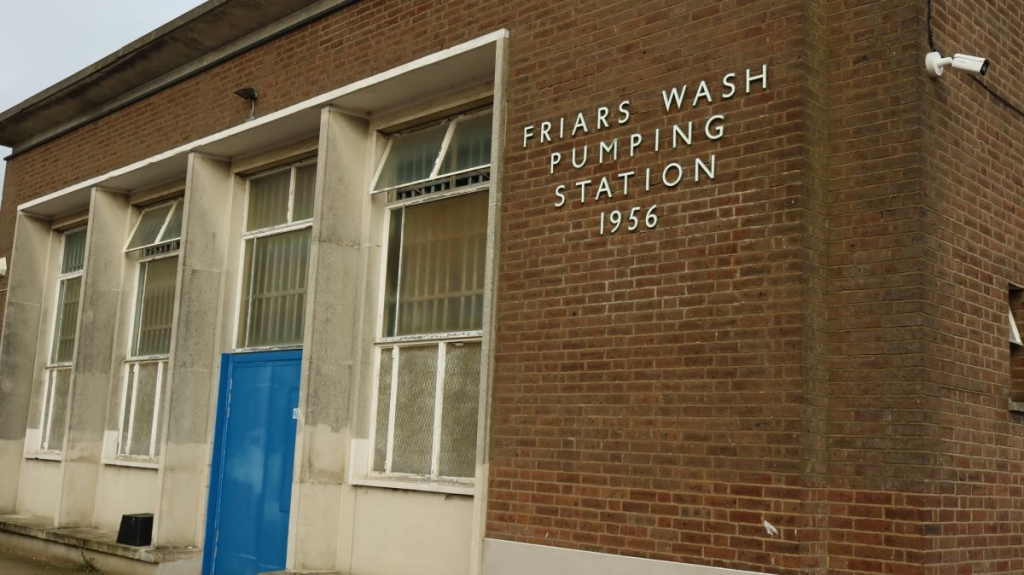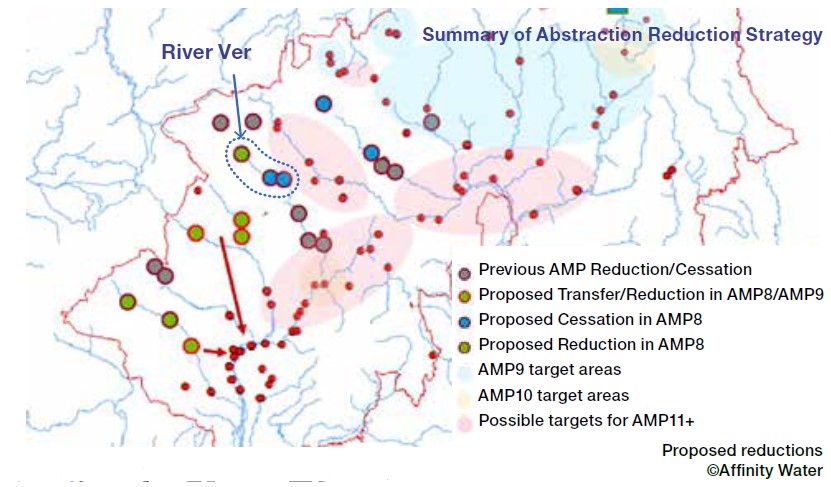Abstraction reductions on the Ver
Tough times.
One of the main objectives at the Society’s foundation back in 1976 was to campaign for an acceptable flow in the River Ver.
In 1976 – the year of a record long hot summer – abstraction from the Ver Valley was at its height. Almost a 50 million litres a day was being abstracted from the Ver’s catchment, much of it being piped to support the developing town of Luton. What’s more, 50 million litres constituted an unsustainable 50% of the effective rainfall* that falls on the valley every year. This made the Ver one of the most abstracted catchments in the country. Today, it’s generally agreed that sustainable abstraction in a chalk stream catchment should amount to no more that 5-10% of effective rainfall. The dry river bed, slow silty reaches, dead fish and dying invertebrates of 1976 have been repeated a number of times since much to the anger of the citizens of St Albans, Redbourn and the wider area.
Slow progress
Over the past 45 years, the Society has continued to campaign through a period when environmental concerns have come to the fore. In return, the Environment Agency and Affinity Water (and its predecessors) have gradually responded. In 1993 Friar’s Wash pumping station was reduced from 15 million litres a day (Mld) to 3Mld. In 2015 Bow Bridge pumping station was closed. Pumping stations in St Albans city are scheduled to have their average daily abstraction halved to 9Mld in 2024 – hence all the big blue pipework to bring replacement water, that’s been laid on Batchwood Drive and between the city and Redbourn.

Yes! A promise in the pipeline
In their latest draft Water Resources Management Plan (dWRMP), Affinity Water are proposing further reductions at the top of the Ver Valley. Friars Wash will finally be closed even for emergencies, Redbourn pumping station closed and Kensworth, at the top of the valley, reduced to a 1Mld average – a reduction of 3.3Mld.
These proposed reductions will be covered by importing water from Grafham Water reservoir and would be scheduled for 2029. Indeed, Grafham was, at the suggestion of the Society, the source of replacement water to cover Luton after the 1993 reductions and will be compensating for the 2024 cut too.
All this would leave the Ver with just 1Mld being drawn from groundwater at its head, giving the river the best chance of having better flow more often and encouraging our chalk stream to thrive in more sections. Further reductions in St Albans remain possible in the more distant future.

The wider picture
It’s planned that chalk streams in the west of Hertfordshire and into Buckinghamshire will principally rely on the proposed The Grand Union Canal (GUC) Strategic Transfer for a source of supply to replace groundwater abstraction, mostly by 2029.
It would be desirable if all chalk streams could have their abstraction restored to a sustainable level simultaneously. However, the replacement water has to come from somewhere.
Support the other rivers in Herts
Some chalk streams in Hertfordshire, especially those in the east of the county (like the Ivel, Beane, Rib, Quin, Ash and Stort), have been less fortunate than the Ver and plans to restore their flow are not scheduled until 2034 or beyond. The reductions here are generally aligned to the future development of significant infrastructure projects (such as a reservoir near Abingdon) and a very optimistic demand management strategy. Indeed, demand management is anticipated to contribute over 50% of the water needed. Some of this is from the halving of leaks and more from reducing consumer per capita consumption, from the current 155 litres per day 115 by 2050. There is much uncertainty about these targets and consequently considerable doubt about these chalk streams receiving all the help they need.
While eyeing our own possible good fortune we should remember the other river groups and give them as much support as we can. We’ll be taking every opportunity to make the point that more abstraction reductions could be achieved in a shorter timescale with investment in a more robust leak preventions policy; speedier investment in supply infrastructure and less reliance on huge consumer water saving targets. We believe it is imperative that the Government should come to the party with a hard-hitting sustained national communications initiative, otherwise the stiff targets are doomed to fail. What’s more, the approach suggested by independent experts of moving abstraction points/licence transfers from headwater pumping stations to those further down catchments could be adopted more widely and with greater alacrity.
Please consider emailing water.resources@defra.gov.uk (Note: include Affinity Water dWRMP in the email subject field) simply stating that you are in favour of the abstraction reductions planned for the Ver but include a request for the acceleration of solutions for the chalk streams in the east of Hertfordshire. The deadline for replies is 20th February 2023.
The 250+ pages of the dWRMP and associated papers can be viewed here: https://t.co/rITLouWM7t
*Effective rainfall is the rain that soaks though the soil and replenishes the aquifer – the groundwater that not only drives the river but also is the source of the water pumped from the ground for us all to use at home and in business.
Note: AMP = Asset Management Plan. AMP 8 is the 5-year period 2025-2029.